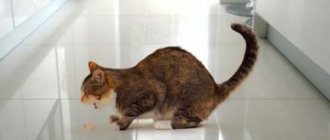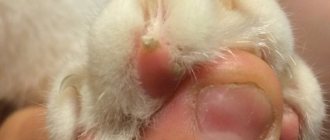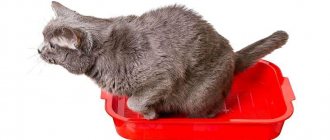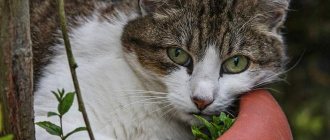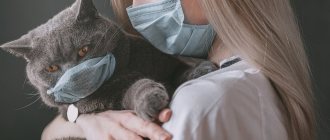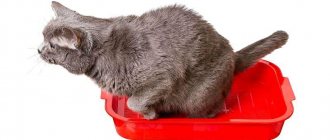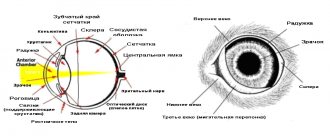Types of vomiting in cats
Sporadic vomiting in a cat can occur with liver disease, kidney disease, diabetes mellitus, worms, chronic gastritis, and irritable bowel syndrome.
Persistent vomiting in cats occurs due to injuries, when the cat eats grass, hairballs or foreign objects, or infectious enteritis.
In the case where there is blood in the vomit, such vomiting usually occurs when a foreign object is swallowed, causing injury to the mucous membrane of the esophagus and stomach. If the owner of the cat detects blood in the vomit of the cat in the form of “coffee grounds,” this indicates bleeding in the stomach or in the upper parts of the small intestine. If there is an unpleasant foul odor from the vomit, it is necessary to exclude intestinal blockage or peritonitis. Sometimes such vomiting in a cat occurs as a result of blunt trauma to the abdomen.
When vomiting is not dangerous
Of course, we don’t want to say that absolutely any case of vomiting is a reason to break out in sweat and start trembling for your pet. Yes, it’s better to play it safe than to rely on chance. But, as we noted above, we need to look at the regularity/frequency of vomiting.
It happens that a cat’s gag reflex occurs only once or twice throughout the day and does not repeat. At the same time, she does not lose her appetite, she does not vilify, and her behavior does not change. Such vomiting is not dangerous for our little brothers and can be caused by the following reasons:
- Overeating - excess food puts pressure on the stomach diaphragm, resulting in a gag reflex. In this case, undigested pieces of food are visible in the vomit. To stop vomiting in a cat, it is enough to reduce the serving size. Moreover, this is necessary, since overeating will sooner or later lead to obesity, and it provokes many serious diseases, including cardiovascular disease and diabetes.
Read about the dangers of obesity: Fat cat - the dangers of excess weight for your cat
- Fasting - in this case, vomiting occurs in a cat who receives food once a day. This diet is not suitable for small predators. They should eat little but often. In this case, the vomit will consist of gastric mucus and foam. By changing the number of meals and its volume, you can stop vomiting.
— Accumulation in the stomach of a small amount of hair that comes from “washing” the cat. A hairball will be visible in the vomit. To make it easier for your pet to get rid of fur in his stomach, buy him a special herb or paste for removing hair.
Read more: Why do we need grass for cats?
— During pregnancy, hormonal changes occur in the expectant mother’s body (and the enlarging uterus puts pressure on the stomach), but the stomach quickly adapts, and vomiting no longer occurs. This mild vomiting lasts no more than 10 days, usually in the morning, and consists of light discharge, undigested food and a small amount of foam.
— A cat can get seasick when transported in any vehicle.
But if a kitten vomits (even just once), contact a specialist immediately, because vomiting weakens and dehydrates the body, which can lead to the death of the animal.
There are several types of vomit in cats.
Vomit with hairballs.
This type of vomiting in cats is considered to be a normal process from a physiological point of view, which occurs in cats 1-2 times a month. Cats in a similar way free their stomachs from the fibers of their fur that have fallen during the process of licking. Such hairballs that have entered the stomach can be removed from the cat's stomach with the cat's feces. Sometimes such lumps in a cat can cause obstruction of the gastrointestinal tract.
Vomiting of whole, almost undigested food.
This type of vomiting in a cat occurs 15-30 minutes after the cat has finished eating. This vomiting occurs in a cat when it has previously been hungry and the animal is forced to eat a large amount of food due to hunger. It happens when, after eating, a cat is forced to engage in active games, jumping, when the food eaten is not able to be absorbed.
Vomit mixed with bile.
Bile is normally located in the gallbladder of a cat and should not normally be contained in vomit from the stomach. The appearance of bile tells its owner about diseases of the gallbladder or liver. When a cat's vomiting is prolonged, then after the contents of the stomach are released, bile begins to be released when the cat vomits. Bile entering the stomach causes inflammation of the gastric mucosa.
Vomiting liquid or foam.
This type of vomiting is preceded by 4-8 reflex muscle contractions of the abdomen. At the same time, the cat tenses and experiences discomfort. When a cat vomits, it stops licking itself, tends to hide in a secluded place and does not pay any attention to others. Sometimes it happens that despite an intense urge to vomit, it is not observed. However, this causes pain in the cat. At the same time, the cat refuses the food and water offered to it, due to the fact that they cause it to constantly vomit, the cat constantly licks its lips.
Vomit mixed with blood.
Individual inclusions of scarlet color in the vomit indicate mechanical damage to the digestive organs. These injuries most often occur in cats when they swallow foreign objects with sharp edges (meat and fish bones).
A rich red color indicates damage to the lower parts of the digestive system. This vomit may be the result of bleeding in the stomach, where the blood reacts chemically with gastric juice. This kind of vomit in cats occurs due to gastritis, malignant neoplasms, and also sharp objects that have entered the stomach.
Green vomit.
Green vomit in a cat occurs with diseases of the liver, gall bladder or intestinal obstruction. With these diseases, there is a large secretion of bile or when the contents of the intestines are thrown into the stomach. Vomiting of green matter in a cat occurs as a result of the cat consuming fresh or dry grass.
The presence of feces in the vomit.
The appearance of feces in a cat’s vomit indicates an intestinal blockage, an injury to the abdominal area, or the presence of peritonitis.
What a cat owner should know when calling a doctor for vomiting
To help a veterinarian quickly determine the cause of vomiting and decide what to give the cat to eliminate it, it is necessary to have the following data:
- time of vomiting;
- frequency and duration of attacks;
- visual characteristics of vomit (color, smell, consistency, presence of impurities);
- connection of vomiting with food intake;
- symptoms accompanying vomiting;
- possibility of poisoning;
- date of last treatment against helminths and ectoparasites.
It is also worth checking whether the animal has free access to the street.
What diagnostic measures are carried out in a veterinary clinic?
When a cat is admitted, the veterinarian conducts a full clinical examination. During which the general condition of the cat’s body, coat, is assessed, body temperature is measured, and auscultation of the respiratory organs and heart is performed. Palpation of the abdominal area determines the tone of the abdominal muscles and determines the presence of certain foreign formations. To correctly judge the cat’s health, specialists must conduct a general and biochemical blood test, a blood test for the presence of parasites, pathogens of infectious diseases, a general urinalysis, a stool test for helminths, an ultrasound of the abdominal organs, and an ECG.
How to help a kitten?
If your kitten is vomiting frequently, adoption experts recommend contacting your veterinarian immediately. The same should be done if the vomit contains bile, blood, worms, or a large amount of mucus. The clinic will measure your temperature so as not to miss any serious changes in your body. With infectious diseases and inflammatory processes, the temperature will rise. In case of poisoning and shock - decrease.
It is necessary to understand that vomiting is not a disease, but in most cases a sign of some disease. Therefore, it is necessary to identify the cause of the cat’s vomiting, and this can only be done by a specialist.
Before visiting the veterinary clinic, remember what you fed your pet. Perhaps you replaced one food with another or there was contact with another animal. Take a good look at what the vomit consists of, as well as its color. Tell your doctor about this.
First aid
To alleviate some of the general condition of your cat, you need to stop feeding it for a day; you can leave free access to water, but only if the water does not cause new vomiting.
In the case when the cat vomited once and the cat feels normal after that, then the owner is not required to carry out treatment.
If a cat vomits more than three times a day, as a result of which the cat becomes depressed and painful, then after visiting a veterinary clinic, the cat is put on a special diet and food is limited. To prevent dehydration, the cat is prescribed Regidron solution or saline solution. If the cat refuses water, Ringer's solution is injected subcutaneously.
Treatment of vomiting should be aimed at eliminating the underlying cause of the cat's vomiting.
If the gastrointestinal tract is blocked by wool, pieces of wool are removed with a special probe. A conservative method of removing hair is to give it food with a high fiber content or prescribe drugs that cause rapid evacuation of hair from the stomach - Malt paste. Surgery is performed to remove hairballs.
The cat is given phenothiazine, torecon, and passertin as an antiemetic. If a cat's vomiting is caused by poisoning, it is prescribed internally with activated carbon (1 tablet per 10 kg of body weight), smecta, enterosgel and other adsorbent substances. To speed up the elimination of poisons that have entered the body, diuretics are prescribed.
In a veterinary clinic, to relieve intoxication, the cat is prescribed droppers with a solution of glucose and ascorbic acid.
For infectious diseases, a course of antibiotics is administered.
When vomiting caused by worms, deworming is carried out first.
"Dangerous" vomiting
Let's look at the most common - and most alarming - reasons why a cat vomits.
1) Infections
This is one of the most common causes of vomiting. And first of all, it is worth highlighting panleukopenia. This is a viral disease (the so-called “feline distemper”) with a very high mortality rate. The main method of infection is contact with an already sick animal (cats can also become infected from dogs) or its secretions. But the virus can also be transmitted by blood-sucking insects or can be carried by the owner on shoes, so even exclusively pets, if they are not vaccinated, are not 100% protected from panleukopenia.
Read about the disease: What is panleukopenia in cats
If your kitten is vomiting frequently, accompanied by diarrhea and refusal to eat, then it is better to play it safe and immediately contact a veterinary clinic. Then either you will make sure that the most dangerous cause of the painful condition is absent, or you will begin to treat the infection at an early stage, when there is a good chance of saving your pet. You should be especially concerned if the cat is not vaccinated.
2) Gastrointestinal diseases
An equally common cause is inflammatory processes in the gastrointestinal tract. These are diseases such as gastritis, gastroenteritis, colitis, pancreatitis, etc. All of them are accompanied by vomiting, often mixed with bile. Lack of treatment will lead to the death of the pet.
Read more about intestinal diseases: Treatment of intestinal diseases in cats
3) Poisoning
Of course, various poisonings can also cause vomiting in a cat: stale food, chemicals, medications - the latter is especially important if the owner is self-medicating, so we once again warn you against this. Needless to say, poisoning leads to acute intoxication of the body and, if the pet is not urgently provided with help, severe consequences, including death, are possible.
4) Brain problems
Perhaps this is not the most common reason why a cat vomits, but in terms of the degree of danger it is not inferior even to viral infections. Problems can arise due to head injuries with consequences such as concussion, edema, and increased intracranial pressure. Viruses or bacteria can also enter the brain and cause encephalitis and/or meningitis, both of which cause severe vomiting.
5) Volvulus, intestinal obstruction, etc.
An obstruction may occur, for example, due to a large hairball or small bones stuck in the intestines. In this case, only surgery will help.
6) Helminths
Another cause of vomiting is poisoning by waste products of worms. Large amounts of worm feces release toxins that are harmful to the cat.
Read more about the problem: What are helminths in cats
7) Vomiting during pregnancy
If during pregnancy a cat vomits for more than two weeks and the vomiting is accompanied by a decrease in temperature, diarrhea, and dehydration, this may be an acute pathology of some disease. The owner needs to contact the clinic as soon as possible to avoid serious consequences for the mother and fetus.
Thus, vomiting can indicate many pathologies. But among those listed above there are none that can be ignored without consequences. In other words, repeated vomiting, especially if it is accompanied by other alarming symptoms, should prompt the owner to immediately contact a specialist to establish an accurate diagnosis and begin treatment.
Preventing vomiting in cats
Prevention of vomiting in cats should be based on feeding fresh, good-quality food or purchased commercially produced food. Avoid feeding your cat raw fish and meat. Your cat must be vaccinated against infectious diseases common in your region. In order to prevent helminthic diseases, it must be treated for worms twice a year. If you keep cats of long-haired breeds, it must be brushed regularly so that its gastrointestinal tract does not become clogged with hair. In order to monitor its health, the cat must be periodically shown to the clinic’s veterinarian.
How to understand that the body is dehydrated
The Murkoshi team of specialists would like to draw your attention to the fact that the danger of vomiting for a kitten lies, among other things, in dehydration and imbalance of water and electrolyte balance. The number of ions responsible for the transmission of nerve impulses decreases, and as a result, the functioning of the cardiovascular, nervous and other body systems deteriorates.
You can determine dehydration in the following way: take the skin on the withers with two fingers, lift it and release it. If the skin does not immediately return to its normal position, but remains stuck together, it means the cat is dehydrated. The condition of the wool also changes when dehydrated - it becomes dry and does not shine (dull).
Treatment
Treatment for mild versus chronic vomiting in cats can vary greatly. When choosing treatment methods, the veterinarian determines not only the medications that should be given to the cat for vomiting, but also what to feed the animal.
Treatment for mild vomiting in cats
The list of measures to eliminate mild vomiting includes ensuring that food is retained in the gastrointestinal tract for 6-8 hours and developing a special diet.
Diet rules for cats:
- food should enter the body in small portions 5-6 times a day;
- food must be warm;
- The cat's diet consists of boiled meat of lean poultry and sea fish, as well as rice.
A return to a full diet is allowed only after the cat has completely stopped vomiting for a week. It is carried out gradually, over 7-10 days under the supervision of a doctor.
Typically, when treating mild vomiting in cats, antiemetic and detoxifying drugs are not used.
Treatment of chronic vomiting in cats
The main goal of treatment for chronic vomiting in cats is to eliminate the underlying disease that triggered its occurrence.
| Pathology | Treatment |
| Hypochloremic metabolic alkalosis, metabolic acidosis accompanied by dehydration | Intravenous injections of isotonic solutions + 5% glucose solution |
| Hypokalemia | Potassium preparations |
| Microcytic hypochromic anemia | Preparations containing iron + ascorbic acid, B vitamins |
| Gastric or duodenal bleeding | H2 receptor blockers (Ranitidine, Cimetidine), hemostatic agents (vitamin K and its analogues), gastroprotectors (Sucralfate) |
| Hypoalbuminemia, exhaustion | Vitamin-mineral complexes, parenteral nutrition, antiemetics (Cerucal, Metoclopramide) |
The use of antiemetic drugs for intestinal blockage or decreased peristalsis is prohibited. Also, you should not administer them yourself to eliminate vomiting in cats, as this will distort the clinical picture and make it difficult to diagnose the animal.
To subsequently avoid vomiting caused by dietary errors, experts recommend switching cats to super premium or holistic food. They will ensure the cat’s health is maintained, prevent the occurrence of diseases associated with metabolic disorders and increase the animal’s immunity level.



